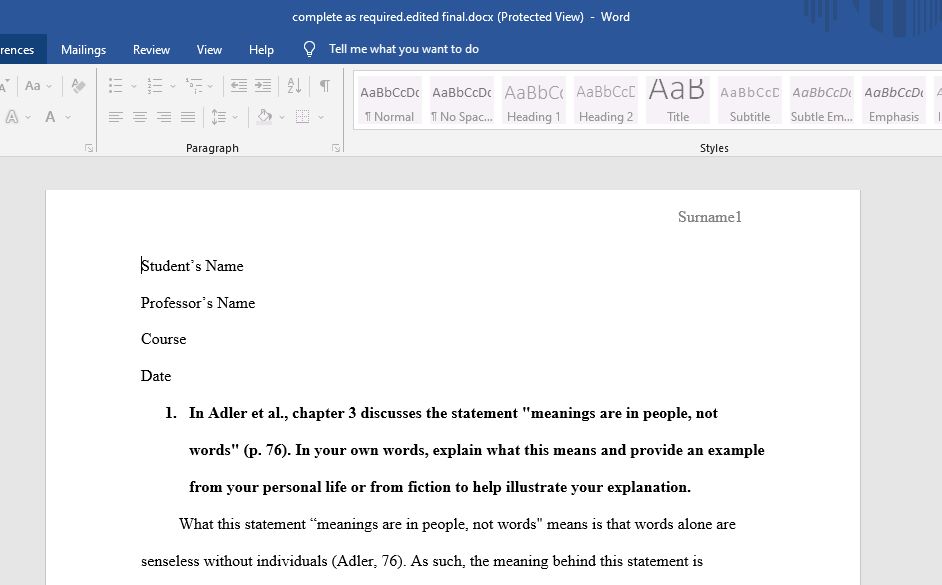Complete as required- “meanings are in people, not words”
Part one
Read Adler, et al., chapters. 3 and 9 and then answer the following questions in approximately 50-100 words each.
1. In Adler, et al., chapter 3 discusses the statement “meanings are in people, not words” (p. 76). In your own words, explain what this means and provide an example from your personal life or from fiction to help illustrate your explanation.
2. In Adler, et al., chapter 3 discusses four “rules” related to the structure of language (pp. 73-76). Explain what each of these terms means or refers to. You must include a page number when using quotes.
a. Language is symbolic (p. 73)
b. Language is governed by rules (p. 74)
c. Language is subjective (p.76)
d. Language reflects and shapes worldviews (p. 76)
Part two
Read Foss chapter 3 and the excerpt from Toni Morrison’s 1993 speech and answer the questions that follow.
Excerpt from Toni Morrison’s Nobel Prize for Literature Lecture, 1993.
https://www.americanrhetoric.com/speeches/tonimorr…
(begins at 28:00)
“You are an adult; the old one, the wise one. Stop thinking about saving your face. Think of our lives and tell us your particularized world. Make up a story. Narrative is radical, creating us at the very moment it is being created. We will not blame you if your reach exceeds your grasp; if love so ignites your words they go down in flames and nothing is left but their scald. Or if, with the reticence of a surgeon’s hands, your words suture only the places where blood might flow. We know you can never do it properly — once and for all. Passion is never enough; neither is skill. But try. For our sake and yours forget your name in the street; tell us what the world has been to you in the dark places and the light. Don’t tell us what to believe, what to fear. Show us belief’s wide skirt and the stitch that unravels fear’s caul. You, old woman, blessed with blindness, can speak the language that tells us what only language can: how to see without pictures. Language alone protects us from the scariness of things with no names. Language alone is meditation.
“Tell us what it is to be a woman, so that we may know what it is to be a man; what moves at the margin; what it is to have no home in this place; to be set adrift from the one you knew; what it is to live at the edge of towns that cannot bear your company.”
“Tell us about ships turned away from shorelines at Easter, placenta in a field. Tell us about a wagonload of slaves, how they sang so softly their breath was indistinguishable from the falling snow; how they knew from the hunch of the nearest shoulder that the next stop would be their last; how, with hands prayed in their sex, they thought of heat, then suns; lifting their faces as though it was there for the taking, turning as though there for the taking. They stop at an inn. The driver and his mate go in with the lamp, leaving them humming in the dark. The horse’s void steams into the snow beneath its hooves, and its hiss and melt is the envy of the freezing slaves.”
1. Explain in your own words what logos, ethos and pathos refers to according to Foss. Cite the source and page number.
a. Logos
b. Ethos
c. Pathos
2. Find and identify an example of logos and pathos in the above excerpt from Toni Morrison’s Nobel Prize for Literature Lecture (1993) and explain how each example fits the term
a. Logos
b. Pathos
3. In traditional criticism, we often assess how the canons of rhetoric help illuminate what’s going on in the message. Briefly explain each of the five canons of rhetoric according to the assigned readings; clearly indicate your source(s) and the page number for this information.
a. Invention
b. Arrangement
c. Style
d. Delivery
e. Memory
Answer preview:

word limit:450
